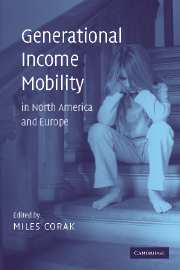Book contents
- Frontmatter
- Contents
- List of figures
- List of tables
- List of contributors
- Preface
- 1 Generational income mobility in North America and Europe: an introduction
- 2 A model of intergenerational mobility variation over time and place
- 3 Equal opportunity and intergenerational mobility: going beyond intergenerational income transition matrices
- 4 Intergenerational mobility for whom? The experience of high- and low-earning sons in international perspective
- 5 What do trends in the intergenerational economic mobility of sons and daughters in the United States mean?
- 6 Changes in intergenerational mobility in Britain
- 7 Intergenerational mobility in Britain: new evidence from the British Household Panel Survey
- 8 Non-linear patterns of intergenerational mobility in Germany and the United States
- 9 Family structure and labor market success: the influence of siblings and birth order on the earnings of young adults in Norway, Finland, and Sweden
- 10 New evidence on the intergenerational correlation in welfare participation
- 11 Intergenerational influences on the receipt of unemployment insurance in Canada and Sweden
- 12 Unequal opportunities and the mechanisms of social inheritance
- Index
- References
8 - Non-linear patterns of intergenerational mobility in Germany and the United States
Published online by Cambridge University Press: 22 September 2009
- Frontmatter
- Contents
- List of figures
- List of tables
- List of contributors
- Preface
- 1 Generational income mobility in North America and Europe: an introduction
- 2 A model of intergenerational mobility variation over time and place
- 3 Equal opportunity and intergenerational mobility: going beyond intergenerational income transition matrices
- 4 Intergenerational mobility for whom? The experience of high- and low-earning sons in international perspective
- 5 What do trends in the intergenerational economic mobility of sons and daughters in the United States mean?
- 6 Changes in intergenerational mobility in Britain
- 7 Intergenerational mobility in Britain: new evidence from the British Household Panel Survey
- 8 Non-linear patterns of intergenerational mobility in Germany and the United States
- 9 Family structure and labor market success: the influence of siblings and birth order on the earnings of young adults in Norway, Finland, and Sweden
- 10 New evidence on the intergenerational correlation in welfare participation
- 11 Intergenerational influences on the receipt of unemployment insurance in Canada and Sweden
- 12 Unequal opportunities and the mechanisms of social inheritance
- Index
- References
Summary
Until recently, the literature examining economic mobility across generations has focused almost exclusively on the average association between earnings of parents and their children (Altonji and Dunn 1991, Becker and Tomes 1986, Solon 1992, and Zimmerman 1992). This viewpoint has largely been maintained in studies of individual countries as well as in the few existing direct international comparisons (Björklund and Jäntti 2000, Couch and Dunn 1997, and Dearden, Machin, and Reed 1997). A more recent literature, appealing to policy concerns as well as theoretical predictions, has begun using non-linear estimation techniques to examine intergenerational mobility at different points in the distribution of earnings. This chapter extends prior research by examining whether patterns of mobility in Germany and the United States are similar across the distribution of earnings.
The motivations for this type of study primarily originate from concerns regarding economic opportunity. The economic position of the family into which a person is born is a matter of chance. If people, based on their family of origin, face fundamentally different life prospects, many feel that public policy should attempt to equalize those life chances. One measure of whether an individual born into a particular type of family faces different prospects than others is whether his earnings as an adult are closely related to those of his parents. If earnings are closely related across generations, so that the poor remain poor and the rich remain rich, this might be seen as evidence that we should seek to understand the underlying reasons and adopt policies to assist upward mobility.
- Type
- Chapter
- Information
- Generational Income Mobility in North America and Europe , pp. 190 - 206Publisher: Cambridge University PressPrint publication year: 2004
References
- 17
- Cited by



